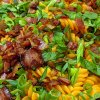
A holiday ham is the delicious gift that keeps on giving—the salty-yet-sweet leftovers add big flavor to any dish in a way many other standard holiday roasts won't (here's looking at you, turkey). And since the ham's already cooked, it's the holiday showstopper that's a fool-proof no-brainer...or is it?
Though holiday hams rank high when it comes to ease of preparation, it's important to note the general cooking time and oven temperature—for the most part, you want to just heat through the ham to prevent overcooking and drying it out. By definition, a ham is a cured pork leg cut, making it safe to eat once heated through. However, label confusion prevails and hams are labeled with anything from "cured" and "smoked" to "fresh" and "uncooked." The latter labels are ham misnomers, as a "fresh" or "uncooked" ham is essentially a raw pork leg cut. (More on how to cook these misnamed hams later.)
Let's start with the basics: Since traditional hams have often been cooked (whether smoked, baked or boiled), the end-goal here is to heat through the ham without drying it out—140˚F is considered the USDA sweet spot where the ham's heated through just enough. A meat thermometer is the surest way to prevent overcooking, as once your ham registers around 130˚F, you'll want to pull it out of the oven to account for carryover cooking—the temperature of the ham will rise another 5˚F to 10˚F while it rests. If you don't have a meat thermometer, scour the label on your ham, as most come with cooking instructions in light of the variance of available ham options on the market.
How long should I cook a ham?
Rach's golden rule when it comes to traditional hams is that they should roast at 325˚F; for bone-in hams, she calls for a cooking time of 20 minutes per pound, and for boneless or spiral-cut hams, she calls for 15 minutes per pound. To help keep the ham moist and prevent it from drying out, Rach adds water to the roasting pan (after setting the ham on a rack to roast) and covers the ham with foil.
Spiral-cut or -sliced hams are pre-sliced for ease, producing thin, even slices as you carve the ham from the bone. Though safe to eat without reheating, warming them through intensifies the flavors of the ham, but because these are pre-sliced, they're more susceptible to becoming dried out if overcooked—consider yourself forewarned and pay attention to the cooking time!
How long should I cook a fresh ham?
With a fresh or uncooked ham, a meat thermometer is your best friend, as it will ensure the ham's cooked through and safe to eat without falling victim to overcooking or undercooking. A good rule of thumb is to plan on starting off the ham in a high-temperature oven—around 500˚F for 20 minutes or so—to give the outside a good sear, before lowering the temp to about 350˚F and cooking it for 20 to 25 minutes per pound or until the ham reaches an internal temperature of 160˚F. Like any cut of meat, the ham will need to rest for 10 to 20 minutes—the bigger it is, the longer it will need to rest—so that the juices can redistribute their flavor.
How do I glaze a ham?
Rach likes to either baste with the glaze every 20 minutes or so during the last half of cooking, or she'll pour the glaze over the ham just before it's done heating through and crank up the oven temp to 425˚F. The ham gets returned to the oven to crisp up for another 10 to 15 minutes, resulting in a glaze that's deliciously crackly in spots.


